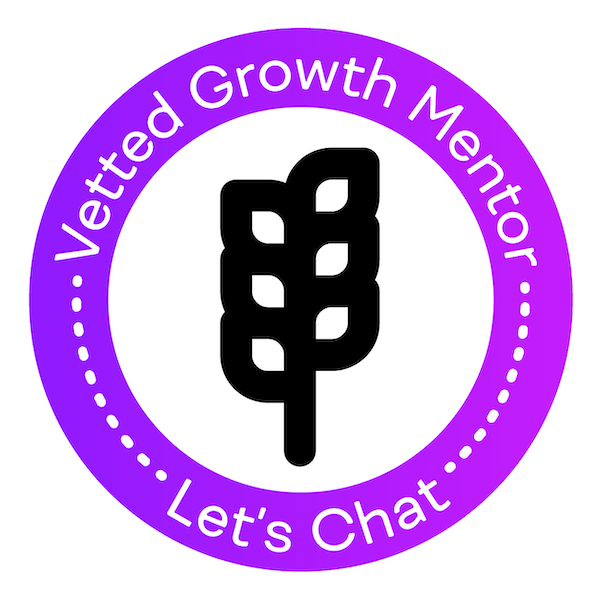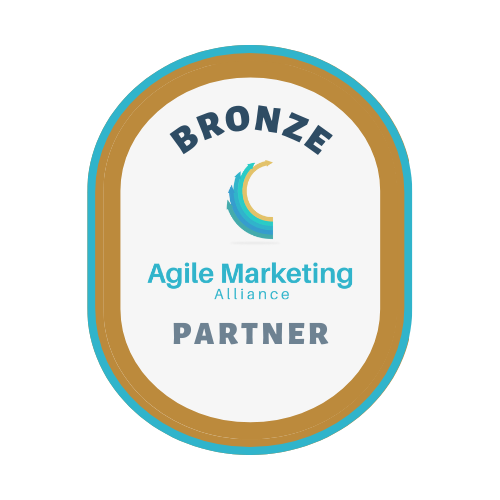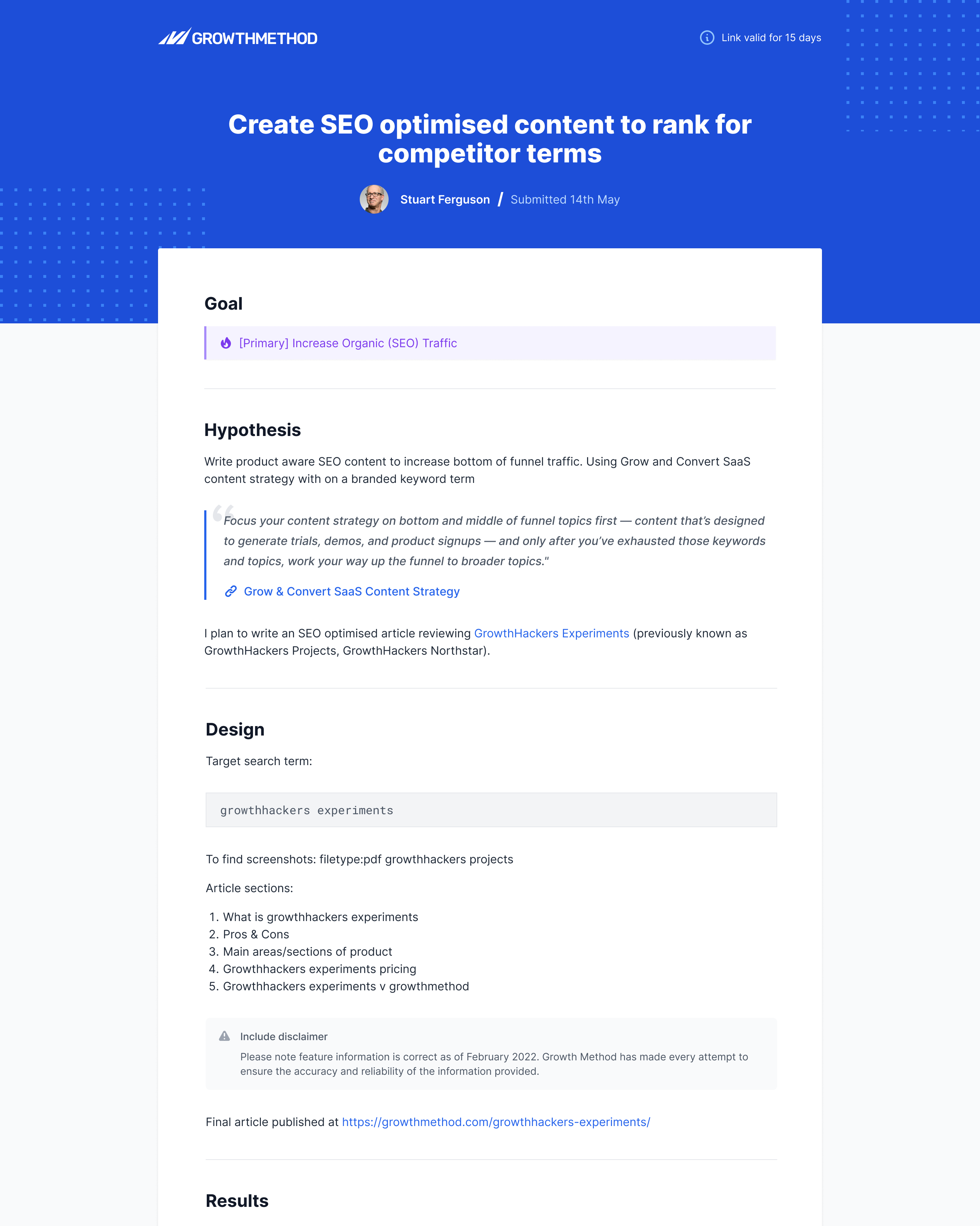Growth hypothesis best practises & high impact work
Article originally published in March 2022 by Stuart Brameld. Most recent update in February 2023.
Request a demo
Project management for growth and agile marketing professionals. Map your acquisition funnel, integrate analytics and run agile experiments.
Experiment results
Recent experiments results include competitor SEO, AI-driven content, exit-intent modals and AB testing homepage headlines.
Case study
"We are on-track to deliver a 43% increase in inbound leads this year. There is no doubt the adoption of Growth Method is the primary driver behind these results."
![]()
Certified
We are vetted mentors with Growth Mentor and a partner with the Agile Marketing Alliance.
In 2009, having recently expanded operations from San Francisco to New York, AirBnB were failing to increase bookings and were heading towards bankruptcy. The founders went to New York and spoke with hundreds of hosts in a last ditch effort to save the business, and came away with a hunch. The hunch was turned into a hypothesis, tested quickly, proved correct, and to this day is widely attributed to the transformation of AirBnB into a household brand and one of the world’s most valuable companies.
This article dives deep into how to build a library of high quality marketing ideas in order to achieve your business goals. It also explains why smart people don’t consciously choose to do low impact work, but often spend their time doing exactly that.
Avoiding low impact work
Clearly, our time is best spent on high impact work. Typically we aim to focus on the stuff that is high impact but requires little effort first (the quick wins) before moving onto that which is high impact but requires more effort (the bigger projects).
There is plenty of evidence to suggest prioritising work in this way leads to a better work-life balance, reduces stress and helps teams focus.
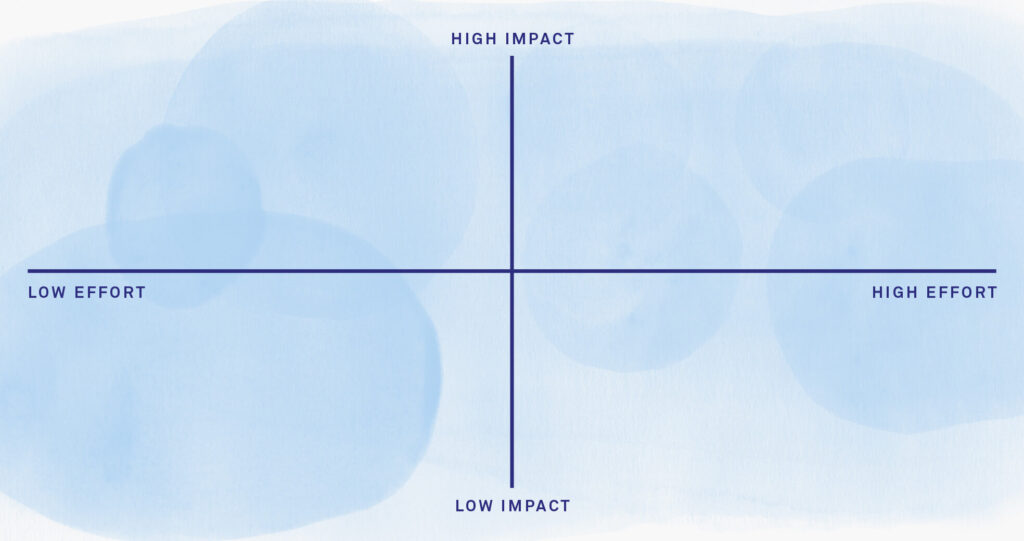
Clearly most people do not actively choose to work on low impact work, though if you look inside many organisations and marketing teams, a lot of time is spent here.
Why?
The first rule of prioritisation – no snacking
A conversation between two Silicon Valley heavyweights (Des Traynor and Hunter Walk) resulted in one of the best explanations as to the challenge, and the magnetic pull, of low-effort low-impact work.
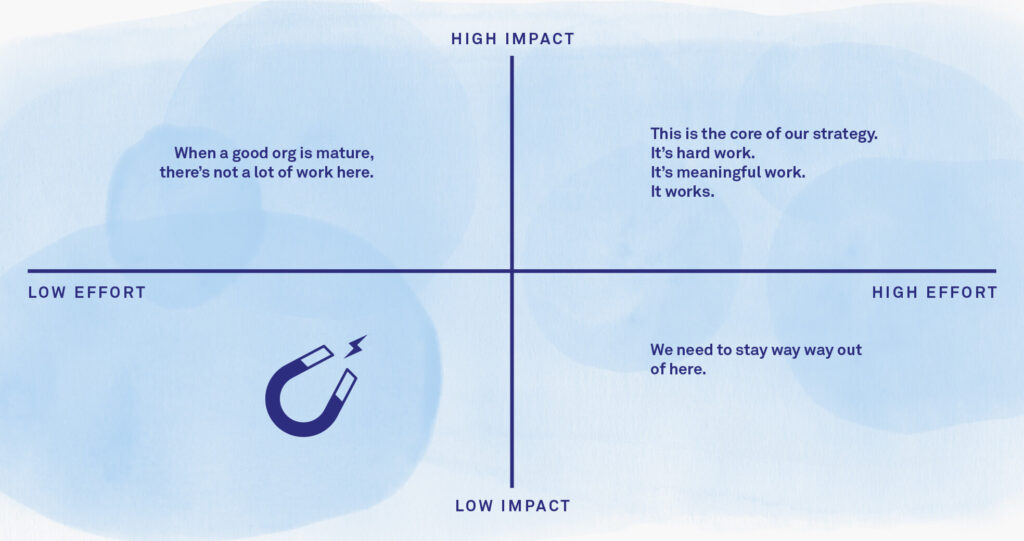
In reference to the quadrant above, and the prioritisation of work in general, Hunter Walk noted:
“The high-effort, high-impact work reflects the strategy you’re deliberately deploying. Everyone’s favourite quadrant is the low-effort, high-impact stuff. But when you continually pick the low-hanging fruit, the branches will stop growing, so this work dries up quickly as your team matures. Most [companies] are sensible enough to avoid the high-effort, low-impact work, so it’s the last quadrant that’s worth talking about.
It’s the low-effort, low-impact work that can kill you, because it’s so attractive. Hunter refers to it as “snacking”. It feels rewarding and can solve a short term problem, but if you never eat anything of substance you’ll suffer.
This work is easy to justify because “it only took 30 minutes”. And when it achieves nothing useful, it’s easy to excuse because it “took us so little time”. This is not strategy – this is flapping. Do this enough times and you’ll grow a low impact team that doesn’t achieve anything.
The default position for a smart team without a clear plan is to snack.”
Source: The first rule of prioritisation
Good marketing ideas aren’t enough
For marketing teams to be effective, the challenge is therefore knowing what is high impact work. Put simply – out of the hundreds of things you or your team could work on today, what is likely to have the biggest impact on your objectives?
Let’s assume we work for a B2B technology company. We know 20% of people that sign-up for our online sales demo convert to paying customers, so our objective for the year (our north star metric) is to increase the number of demo requests coming through our website.
Our team has followed best practises to come up with good experiment ideas, and we have a list of 50 marketing activities we could work on, including:
- Running Google ads promoting content to target customers with a demo request CTA
- Adding a demo request button to the header navigation of the website
- Including the demo request action in a short nurture sequence after people download gated content
- Using pop-up modals instead of inline forms to increase conversions
- Running an ABM campaign to an existing vertical promoting relevant content with a demo CTA
These are all excellent ideas, but there are 50 of them in total.
Which are the high impact ones?
What should we work on first?
Without some kind of prediction as to the outcome, it is impossible to know. Without some kind of prediction as to the outcome, it is impossible to prioritise work.
What is a growth hypothesis?
Modern marketing teams at companies like HubSpot, IBM, LinkedIn, Slack and Amazon operate in largely the same way as the scientific method you likely studied at school – driven by data, process and experimentation. The scientific method has been in use since the 1600s largely as a systematic way to acquire new knowledge.
These teams form a hypotheses before testing new ideas. The hypothesis outlines what you expect to happen and why.
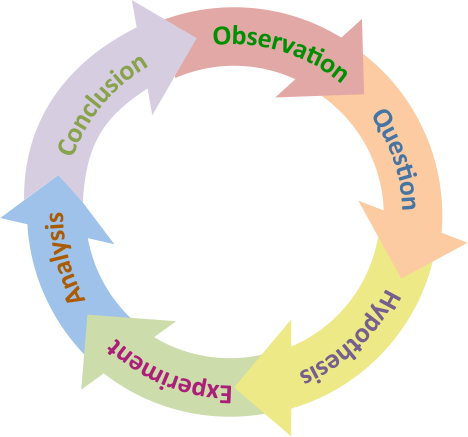
Once a clear hypothesis exists, it can then be tested and proved right or wrong, before analysing the results.
The benefits of a growth hypothesis
As the first step in the process, a good hypothesis is the key to a high impact, high performance marketing team.
A good growth hypothesis:
- Is based on some kind of research or data
- Clearly explains how the idea aligns with the team objective
- Is testable
- Helps with gathering marketing insights
- Allows a team to assess the likely impact of an idea and therefore to prioritise high impact work.
How to structure a growth hypothesis
A simple hypothesis represents what a marketer predicts will happen in an experiment and includes the assumptions behind the prediction.
It is usually written in the form of an if-then statement (e.g. IF a specific action is taken THEN a certain outcomes is expected BECAUSE of some assumptions).
We actually prefer the Hypothesis Kit v3 and Hypothesis Kit v4 frameworks:
- Because we saw (data/feedback)
- We expect that (change) will cause (impact)
- We’ll measure this using (data metric)
Teams may find it useful to include other information alongside the hypothesis, such as:
- Who will you target?
- What will be created? When it will appear?
- What problem (or behaviour) are you attempting to solve (or highlight)?
- What do you believe about your users/visitors? (pains, behaviours, feelings, motivations)
The AirBnB growth hypothesis
Let’s get back to our opening story.
After speaking with AirBnB hosts in New York in a last ditch effort to save the company from bankruptcy, the founders had a hunch that lodgings with better photos were more popular on the site. They weren’t sure, so they came up with a hypothesis and a way to quickly test their hunch.
Hypothesis
If hosts have professional photographs, then they will get more business because guests trust good quality photos more than any other information when booking a host residence.
Experiment
The team realised the fastest way to test the hypothesis was to hire a professional photographer to travel to Airbnb residences and take photos. It was a completely manual solution, it wasn’t scalable, or automated, but that didn’t matter.


Experiment result
Professionally photographed listings get 2-3 times more bookings than the market average. Travellers are, on average, two and a half times more likely to book listings with good quality photos, earning their hosts an average of $1,025 per month.
The test was an enormous success. After 2 years of little growth, this small test completely changed the trajectory of the business, and has been widely attributed to the success of AirBnB today.
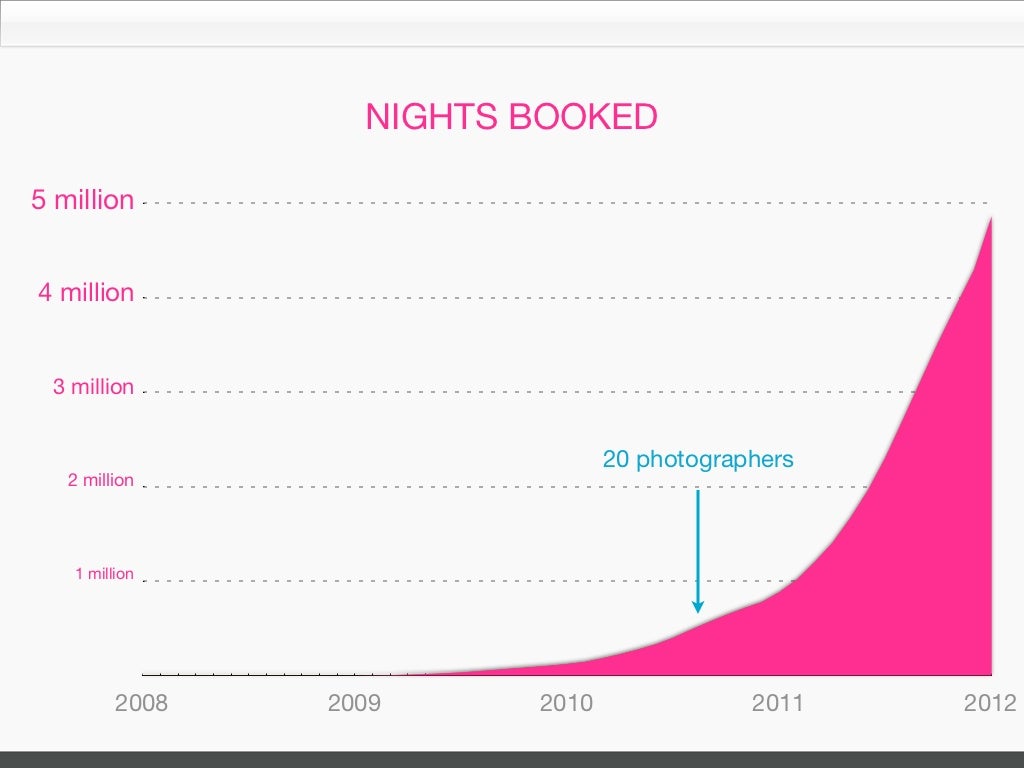
AirBnB mitigated risk by validating their hypothesis before investing the resources required to build an automated solution.
Today AirBnB has a dedicated Pro Photography page that connects hosts with thousands of freelance photographers across 6 continents. The process is almost entirely automated and operates at enormous scale, with payment for freelance photographers automatically deducted from future AirBnB bookings (usually paid for in one or two nights bookings).
Growth hypothesis examples
Here are 4 examples of growth hypotheses from recent Growth Method experiments:
1. Change primary CTA to get a quote
If we change the primary CTA on our product page from a generic contact us form to a more specific quote request tool then we’ll increase conversions by 25% because the value to the customer and next steps are clear and specific.
2. Use pop-up modals over inline forms
If we use pop-up modals rather than inline forms for our content then conversions will increase by 25-30% because modals force the user to make a decision, rather than being tucked away amongst other content with a more passive call to action (based on research from LeadPages)
3. Show related content on product pages
If we show related articles on product pages visitors then we’ll see visitors sessions and repeat visits increase by 10% because visitors will understand there is a depth of related content on our website.
4. Implement drip emails post content download
If we create a series of relevant, educational emails to send to prospects after they download content then we’ll see a 5% increase in qualified leads, equating to 5 new leads per month, because more people will be given the opportunity to build trust with our brand and further engage with us over time.
From a good to great hypothesis
A great growth hypothesis is based on some kind of research or data. Great hypotheses aren’t random.
Great growth hypotheses are based on analysis or observation of some kind of data. This can be quantitative or qualitative data but is preferably data you have gathered about your users (known as first party data).
Here are examples of popular data sources for growth hypotheses:
| Data / Research | Type | 1st or 2nd Party |
|---|---|---|
| Previous experiments | Quantitative | First Party |
| Analytics Data (e.g. Google Analytics, FullStory, CrazyEgg) | Quantitative | First Party |
| Surveys, Support emails, User surveys & other customer data | Qualitative | First Party |
| Competitor Observation | Qualitative | Secondary |
| Blogs & Industry benchmark data | Qualitative | Secondary |
Good growth hypothesis resources
Here are some additional links you may be helpful:
- Hypothesis Kit for A/B testing http://experimentationhub.com/stories/hypothesis-kit.html
- Hypothesis Kit v4 https://optimiseordie.medium.com/hypothesis-kit-v4-4a1441f77ddc
- Never start with a hypothesis https://towardsdatascience.com/hypothesis-testing-decoded-for-movers-and-shakers-bfc2bc34da41
- Speero’s hypothesis bluerpint https://speero.com/blueprints/problem-statement-focused-hypothesis
- How to write a hypothesis https://www.widerfunnel.com/blog/how-to-write-a-hypothesis/
